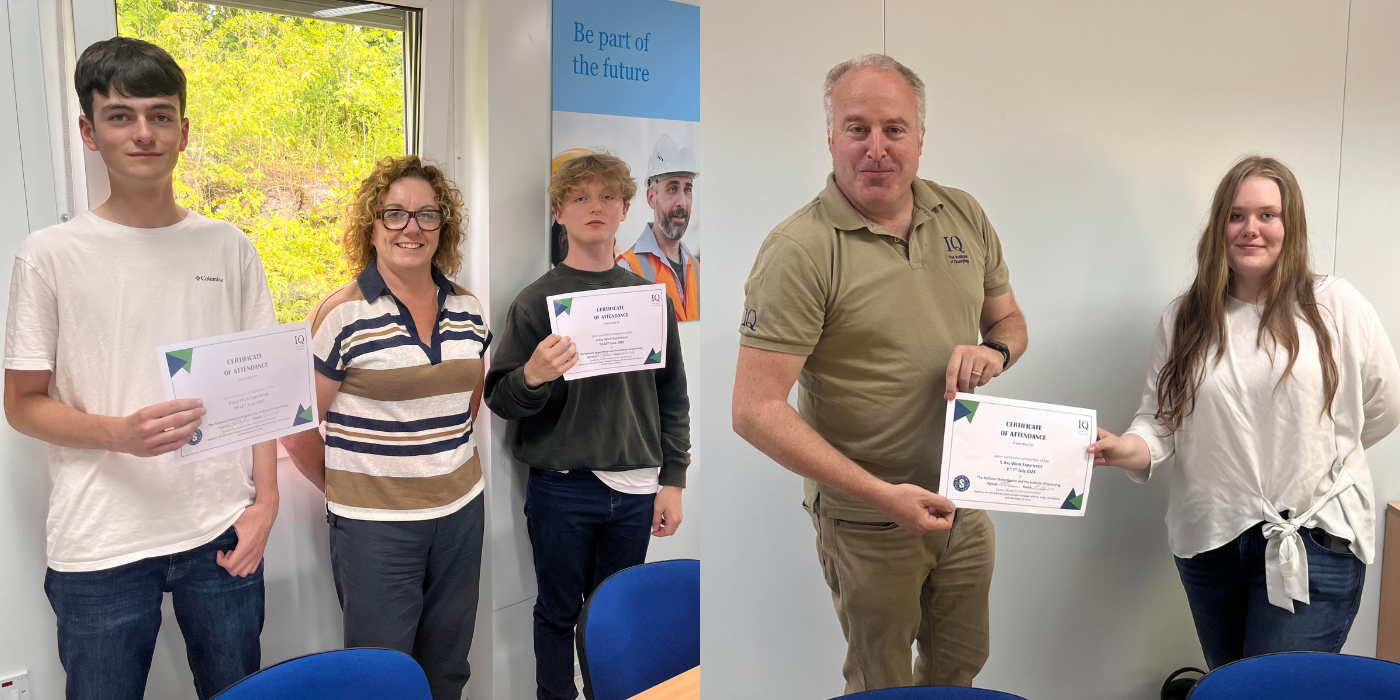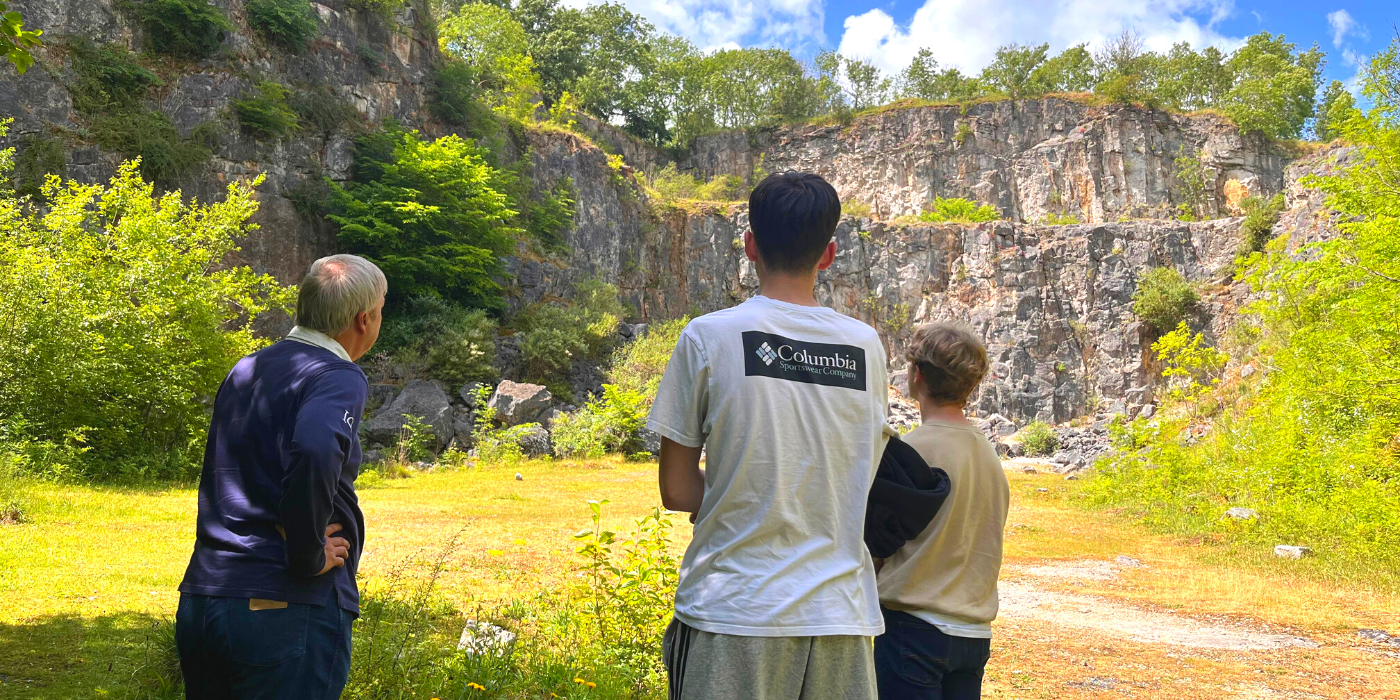
Students from Highfields School in Matlock, Derbyshire recently saw the subject of geology brought to life through a week of work experience hosted by the National Stone Centre (NSC). The schedule contained a wide variety of educational activities carried out in real-world environments and demonstrated the many career opportunities available relating to geology, mining and quarrying.
Two A Level students attended the first week followed by a Year 10 student for the second week. Wanda Zablocki, IQ’s Welfare Officer and STEM Officer, developed the work experience programme and assisted the students throughout their experience.
Students were given an overarching project for the week focused on supporting the NSC. Students conducted local research into similar tourist attractions and gathered feedback from locals and visitors regarding the NSC’s offer and its ambitious redevelopment plans.
The work experience began with a 'meet the team' session where students met representatives from both the NSC and the Institute of Quarrying (IQ) where they learned about the significance of the quarrying and mineral products industries.
Then the students took part in a tour around the NSC’s geological site of special scientific interest (SSSI). Led by Julian Smallshaw, IQ Head of Education and Viv Smith, NSC Volunteer, students were given an insight into how the site would have looked over 330 million years ago, through evidence left behind through fossilised sea creatures such as crinoids and brachiopods.
Julian says: ‘The students were fascinated by the rich geology of the NSC’s landscapes. As the site was once a coral reef seabed and home to a host of sea creatures, the tour gave the students an opportunity to see history up close and imagine how the site would have once looked millions of years ago.’

Mining has played a significant role in the rich history of Derbyshire, and to this day is still celebrated through local historical landmarks, museums and exhibitions. So another exciting tour in the schedule included a guided exploration into the depths of Ecton Mine. The preserved mining site was once known for its rich copper deposits. Operating for centuries, it played a crucial role in the development of the mining industry in the region.
The A Level students toured the salts level and the mine itself, explored various mining tunnels and were shown the conditions in which miners would have once worked by candlelight.
Wanda says: ‘We were shown the evidence of the extraction and techniques used, we were told what the extracted products were used for, how the products were transported to and from the mine as well as shown samples of materials that were extracted in the visitor centre.’
Adding to the Year 10 student’s knowledge of local mining, Clare Herbert, Museum Manager at the Peak District Mining Museum (PDMM) arranged a visit to their museum in Matlock Bath. Materials such as galena and lead ore have been mined in the Peak District since before Roman times. The museum provides insight into the mining industry and how it shaped the local landscapes.
With a packed schedule intended to give a taste of geology and quarrying from all angles, students also took in a visit to Longcliffe Quarries Ltd. in Brassington to observe a working quarry site in action.
Known as the UK’s leading independent supplier of limestone powder, Longcliffe has been a family-owned business since 1927 whose operations include the extraction, processing and delivery of over 1.5 million tonnes of limestone and dolomite a year. The business also employs over 170 employees over their two main sites, making them one of Derbyshire’s largest employers.¹
Upon arrival, the students were given an overview of quarrying and how Longcliffe supports the industry, before being kitted out with relevant PPE including boots, safety glasses, hard hats and high-visibility jackets before being guided around the site. During the tour, plenty of stops were made at various viewing platforms where the layout and the processes of the quarry were explained.
Wanda says: ‘Shortly after the tour, we were driven through the quarry to see the benches close up and pass the quarry lake. The students even experienced a lab visit, discovering how employees test the loads that leave the site, ensuring each is of the chemical structure that clients have requested.’
When reflecting on their week, the Year 10 Student said: ‘The staff were incredibly friendly and I have loved every bit of working with everyone. It was interesting to explore the NSC’s geological site and I would happily relive my week of experience again if I could.’
Harking back to their overall project set, the students rounded off the week of work experience with a presentation on their personal findings of local research, which was shared with an audience of members from both IQ and the NSC. Upon finishing their presentations, the students were awarded a certificate for completing their experience and for their contributions to supporting the NSC.
Wanda said “Offering valuable work experience programmes will become part of the broader education offering already provided by the National Stone Centre. We can provide structured outdoor learning opportunities for school-age children aged 7 – 9 years with activities directly related to the school curriculum.”
To find out more information about how the NSC supports schools and education, please contact wanda.zablocki@quarrying.org.
References
¹ www.longcliffe.co.uk. (n.d.). Longcliffe. [online] Available at: https://www.longcliffe.co.uk/ [Accessed 1 Aug. 2023].
